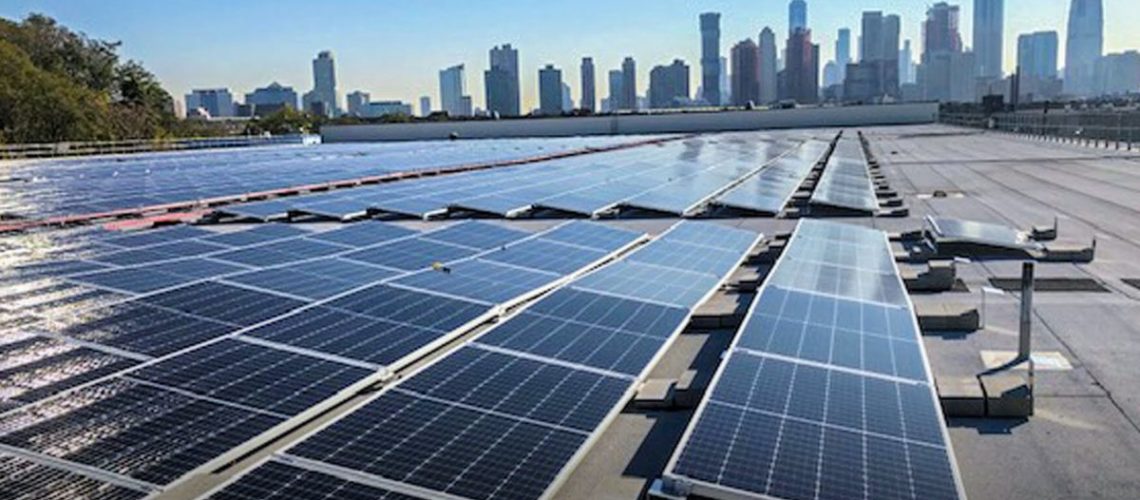During the noon hour on May 18, 2023, NYISO reported that consumer and utility-side solar resources generated 3.33 GW of clean energy output, while the behind-the-meter portion of 3.2 GW and utility-operated 130 MW accounted for 20% of the state’s electricity demand.
New York state may place tenth in the U.S. for solar output, while its 4.65 GW cumulative output may tame in comparison to industry leader California’s solar capacity of close to 35.75 GW. But both states have been seeing a record pace of solar generation represent a fair portion of daily power demand during the time of day when solar irradiance is highest.
During the noon hour on May 18, 2023, the New York Independent System Operator reported that consumer and utility-side solar resources generated a combined 3.33 GW of clean energy output, while the behind-the-meter (BTM) portion of 3.2 GW and utility-operated 130 MW accounted for 20% of the state’s electricity demand for the hour.
The actual peak load on the Empire State’s power system for the entire day of May 18 was 16.166 GW, so the state’s solar resources represented 20.6% at a peak afternoon time of day for the renewable energy asset class.
NYISO estimates BTM production by sampling data from thousands of solar installations across the state. The grid operator’s solar forecasting system uses the samples to estimate the impact of BTM solar at look-ahead periods from 15 minutes to seven days. The solar forecasting system also uses high quality meteorological measurements from the University at Albany’s Mesonet.
The New York State Mesonet is a weather network consisting of 126 weather stations, with at least one station operated in each of the state’s 62 counties. The weather stations report temperature, humidity, wind speeds and also solar irradiance by factoring daily PV watts per square meter of energy output.
At press time for this report, two townships located in the state’s Capital District, Ballston Spa and Glens Falls, N.Y., recorded 604 and 633 w/m of respective solar irradiance, according to the Mesonet database.
In early May, the state passed a law in its 2024 budget that gives the New York Power Authority (NYPA), the state’s largest power authority, the ability to build renewable energy projects to help reach the state’s 2030 climate goals.
The Build Public Renewables Act is the result of about four years of clean energy policy initiatives and looks to solidify the Empire State as not just a leader in community solar deployments but also broader categories like offshore wind and standalone energy storage.
The new law gives the authority power over clean energy directives than the previous 2019 Climate Leadership and Community Protection Act, which set greenhouse gas reduction goals of 70% for its power fleet to come from renewable energy while cutting greenhouse gas emissions by 40% by 2030.
The new law includes several provisions that provide community solar access to low- and middle-income residents (LMI), as well as codified labor and energy justice provisions for workers displaced by fossil fuel projects.
According to the New York Research Development Authority (NYSERDA), the state’s energy development authority, through March 31, 2023 the state had 4.65 GW of solar deployments across 196,130 total projects. The state enjoys a $1.98 per watt cost to install solar, an increase from $1.81/W in 2022, according to the NY Solar Map.
In the Big Apple, the metropolitan region’s five boroughs generated 345.3 MW of solar resources, with this author’s borough of Queens holding the biggest piece, with 125.4 MW or 36% of the region’s solar output.
At 8:45 am local time today, New York City used 5.02 GW of power, or about 34% of the state’s total grid resources, while solar represents about 6.9% of the city’s power mix.
The New York Solar Energy Industries Association (NYSEIA) is holding its 2023 NYC Solar + Storage Summit on June 20, 2023 at the John Jay College in west Midtown. The renewable energy conference will hear from speakers at Con Edison, Clean Capital, the Green Institute at We Act for Environmental Justice, NY Green Bank and PowerMarket, a community solar aggregator, among others.
For more on solar in New York, read 50 states of solar incentives: New York.



